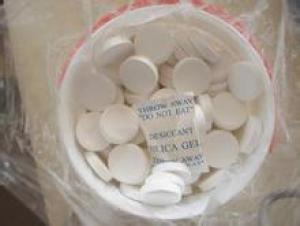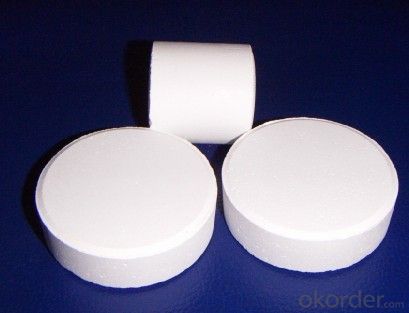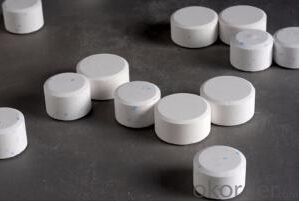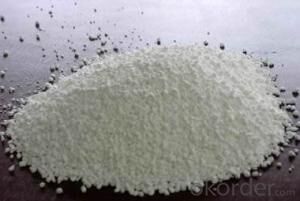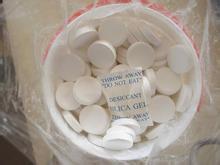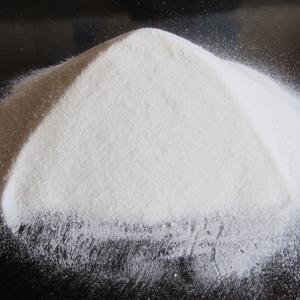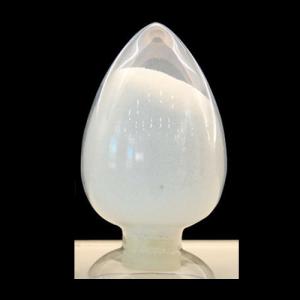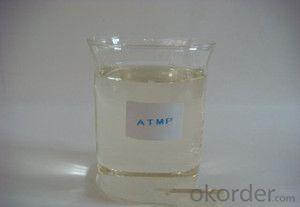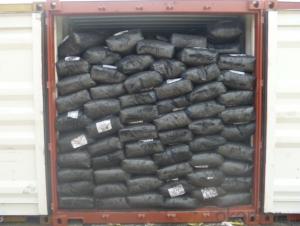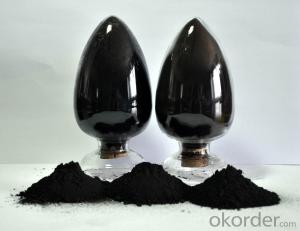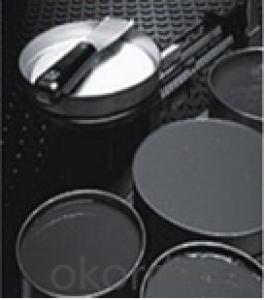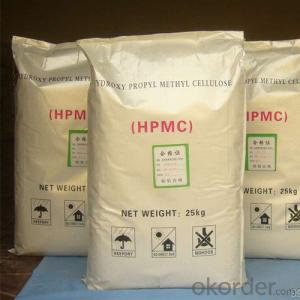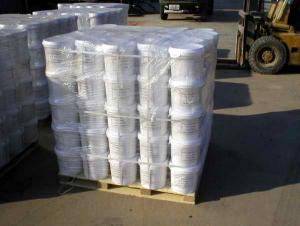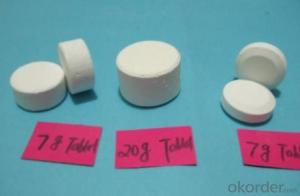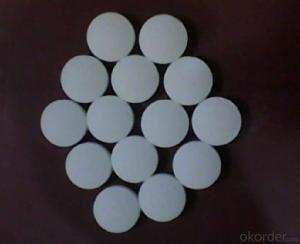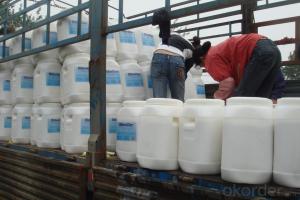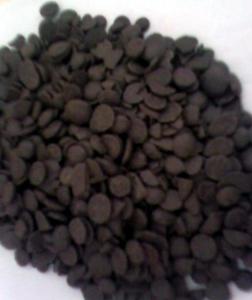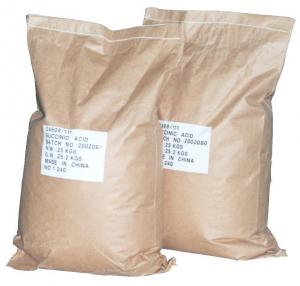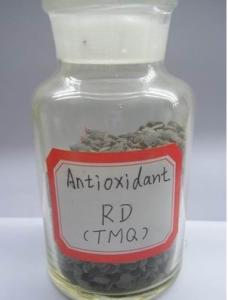SDIC Chlorine Powder Disinfectant Dichloroisocyanurate Sodium
- Loading Port:
- Tianjin
- Payment Terms:
- TT OR LC
- Min Order Qty:
- 22 m.t.
- Supply Capability:
- 1800 m.t./month
OKorder Service Pledge
OKorder Financial Service
You Might Also Like
SDIC
Introduction:
CNBM--SDIC White powder or grain with chlorine odor . It is a strong oxidant and chlorate agent and can dissolved in water easily . Its aqueous solution assumes weak acidity and the active chlorine in its dry products lose little when it is stored for a long time at the atmospheric temperature .
Specification:
Chemical Name | Sodium Dichloroisocyanurate | |
Molecular Formula: | C3O3N3HCL2NA | |
Molecular Weight: | 220.96 | |
CAS Number: | 2893-78-9 | |
Product | 60% | 56% |
Available chlorine(%,min) | 60 | 56 |
Moisture content(% max) | 5 | 8 |
PH Value(1% solution) | 6-7 | 6-7 |
Particles Size:
Mesh | 5~8 | 8~30 | 20~40 | 20~60 |
Main usage:
this products can effectively kill various germs, fung uses and viruses, specially A&B type hepatitis viruses. It is effective on killing algae, decolorizing cleaning water or bleaching .It can be widely used for epidemic prevention, livestock farming , industry and agriculture.
Package:
50KG PLASTIC DRUMS/ FIBER DRUMS.
25KG PLASTIC DRUMS/FIBER DRUMS.
1000KG BIG BAGS.
Or any other packages suggest by customers.

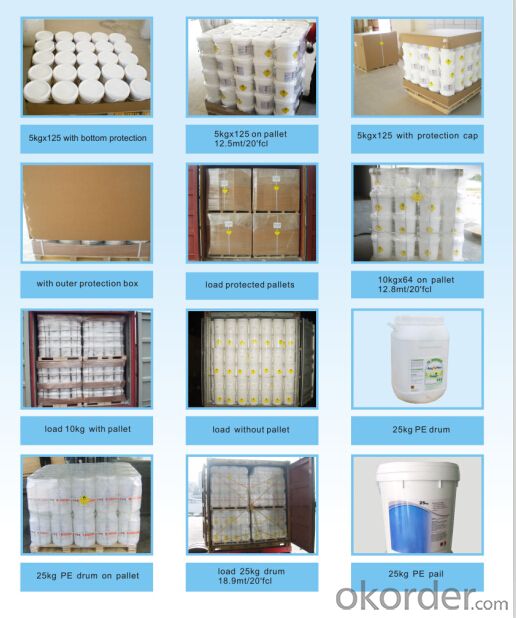
Application of SDIC in water treatment
1)It can be used for swimming pool and drinking water treatment, clean the industrial circulating water.
2)It can be used as preventive disinfection of house, hotel, hospital and public place; used on the environmental sterilization of raising fish.
3)It can be used to bleach the textile, to prevent wool from shrinkage, to prevent paper by decay and act as rubber chlorination.
Delivery Port
Tianjin Port
Payment terms :
T/T,L/C at sight
Storage :
Shall be sealed and stored in the dry and ventilated place to prevent from rain ,high temperature and strong sunlight .
Sample management
Free sample to be offered before place an order.
- Q: High chemistry: Does the catalyst affect the heat and heat of the reaction?
- No effect
- Q: Chemistry GCSE what is a catalyst?
- A catalyst is a substance added to a reaction to speed the reaction up!
- Q: Is the reaction of the exhaust purification of cars (carbon monoxide and nitrogen
- 2NO2 + 4CO = catalyst = N2 + 4CO2
- Q: How are the 4 characteristics of a catalyst (1. organic or inorganic 2. reusable 3. Highly specific, and 4. lowers activation energy) important in preforming life functions? please be as specific as possible, i understand that these are characteristic, i just don't understand why they're beneficial, other than the reusable and lowers activation energy one.
- Organic or Inorganic - the catalyst (enzyme) must be organic to be found in the cell. Catalysts speed up chemical reactions inside a cell and must therefore be organic to be a functioning part of the cell. Reusable - There are so many reactions that catalysts are involved in that it would be a waste for the cell if a catalyst could only last one reaction, especially if there are inhibitors and competition for the active site. Catalysts must be reusable in order to keep the cell functioning. Catalysts always remain unchanged after a reaction. HIihly Specific - Catalysts are only made to catalyze one specific chemical reaction. Their active site has proteins bonded in such a way that only certain elements can enter the active site and H bond with those proteins. The fact that they are highly specific maximizes the productiveness of the cell. And it ensures that the cell only has catalysts to reactions that it needs to be completed. It also ensures that the elements are correctly bonded with eachother. If any two elements could enter the active site, there is no guarantee that the correct product will be produced. Catalysts and Enzymes must be super highly specific in order to properly function. Lowers Activation Energy - The more energy a cell has to spend to catalye a reaction, the worse it is for the cell and the less ATP is has for other reactions. Catalyts hold the substrates together so there is less energy that is needed to have the two substrates react with eachother. Activation Energy is the energy that is needed to start a reaction. So the less energy used by the cell for reactions, the better for the cell. Hope this helps
- Q: It is best to tell me what the role of sulfuric acid in these reactions, respectively
- Esterification reaction (dehydration), nitration (dehydration, concentrated nitric acid), carbonation reaction or dehydration reaction (organic matter in sulfuric acid blackening, dehydrating agent), sulfonation reaction (dehydrating agent), ethylene (dehydrating agent).
- Q: Please help me
- catalyst are enzymes that increase the rate of a reaction. they both are proteins. so basically, a catalyst is an enzyme that increases the rate of a reaction.
- Q: hey people i need your help about my science lab report...the question on my paper says "what function the catalyst?....please help me on this one...i would really appreciate if you leave me answers....much mahalos to all you folkss...thanks
- concepts-blowing on Bandit - it converts Carbon monoxide into Carbon Dioxide (besides as emitting risky debris of Platinum, Iridium and tungsten). hang on - Carbon Dioxide - isn't that the ever so nasty greenhouse gas that we are all meant to be reducing our output of? i'm taking my cats off.
- Q: give an example of how a catalysts speeds up the rate of reaction?? thank you!!?
- Catalysts speed up a reaction, but at the end of it, it's chemically unchanged. You usually have the same mass at the end of the reaction. For example.. Consider the decomposition of Hydrogen Peroxide: 2H2O2 -2H2O + O2 I hope you got how to represent it =D So.. This reaction is very slow. You can try it out in the lab. So when we add a catalyst, the reaction speeds up. The catalyst used here is MnO2.. Manganese dioxide. Well.. The Enzymes in our body are also Catalysts. They speed up the Biological Reactions taking place inside out body. I hope this answers your question. :) Cheers
- Q: I have just spent CAN$550 to replace a catalyst converter at one end of the muffler. The repairman said I need to replace the oxygen sensor very soon, otherwise, the C.C. will be gone again. Is that true... can someone confirm this for me. Thanks.
- With a four cylinder engine, the code definition should have read: B1S1 (for the upstream sensor responsible for fuel/air ratio monitoring) or B1S2 (for the sensor downstream of the catalytic converter, which only monitors that part). If you changed the front (S1) sensor and you still have a code for it, save your old sensor as there may be nothing wrong with it. If the code is for the O2 sensor heater, check your fuses. If not, the code is probably a symptom of another problem, such as a misfire, restricted fuel filter or intake air leak. Is this the same code you got previously? Did you install a direct-fit replacement or a universal sensor that had to be configured for your honda's wiring connector?
Send your message to us
SDIC Chlorine Powder Disinfectant Dichloroisocyanurate Sodium
- Loading Port:
- Tianjin
- Payment Terms:
- TT OR LC
- Min Order Qty:
- 22 m.t.
- Supply Capability:
- 1800 m.t./month
OKorder Service Pledge
OKorder Financial Service
Similar products
Hot products
Hot Searches





